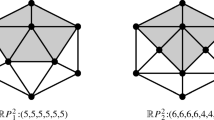Abstract
By an (abstract) Kummer variety Kd we mean the d-dimensiona1 torus Td modulo the involution ϰ ↔ — ϰ. The 2d elements in Td of order two are fixed points of the involution and therefore Kd has 2d isolated singularities (for d ≧ 3). Any simplicial decomposition of Kd must have at least as many vertices. In this paper we describe a highly symmetrical simplicial decomposition of Kd with 2d vertices such that the link of each vertex is a combinatorial real projective space ℝPd-1 with 2d—1 vertices. The automorphism group of order (d + 1)! 2d admits a natural representation in the affine group of dimension d over the field with two elements. A particular case is the classical Kummer surface with 16 nodes (d=4). In this case our 16-vertex triangulation has a close relationship with the abstract Kummer configuration 166.
Similar content being viewed by others
References
A. Altshuler, 3-pseudomanifolds with preassigned links, Trans. AMS 241 (1978), 213–237.
J.-P. Bourguignon, Les surfaces K3, Géométrie riemannienne en dimension 4, Sémin. Arthur Besse, Paris 1978–79, 156–177 (1981).
W. Burau, Über die zur Kummerkonfiguration analogen Schemata von 16 Punkten und 16 Blöcken und ihre Gruppen, Abh. Math. Sem. Univ. Hamburg 26 (1964), 129–144.
J. Cheeger, Spectral Geometry of singular Riemannian spaces, J. Diff. Geom. 18 (1983), 575–657.
H. S. M. Coxeter, The classification of zonohedra by means of projective diagrams. J. Math, pures et appliquées41, (1962), 137–156, reprinted in: Twelve Geometric Essays, 55–74, Southern Illinois University Press 1968.
H. S. M. Coxeter, The derivation of Schoenberg’s star-polytopes from Schoute’s simplex nets, The Geometric Vein, 149–164, Springer-Verlag 1981.
H. S. M. Coxeter andW. O. S. Moser, Generators and Relations for Discrete Groups, 4th ed., Springer-Verlag, Berlin-Heidelberg-New York 1980 (Ergebnisse der Mathematik und ihrer Grenzgebiete, Band 14).
R. D. Edwards, The double suspension of a certain homology 3-sphere is S5, Notices of the AMS 22 (1975), A-334.
I. Fary, Absolute subcomplexes, Ann, Sc. norm, super. Pisa, Cl. Sci., IV. Ser. 4 (1977), 433–471.
G. Fischer, (ed.), Geometrische Modelle, Vieweg-Verlag, Wiesbaden 1986.
B. Grünbaum andG. C. Shephard, Spherical tilings with transitivity properties, The Geometric Vein, 65–98, Springer-Verlag 1981.
R.W. H.T. Hudson, Kummers Quartic Surface, Cambridge 1905.
W. Kühnel, andT. F. Banchoff, The 9-vertex complex projective plane, The math. Intelligencer, Vol. 5, issue 3, (1983), 11–22.
W. Kühnel andG. Lassmann, The rhombidodecahedral tessellation of 3-space and a particular 15-vertex triangulation of the 3-dimensional torus, manuscripta math. 49 (1984), 61–77. [15]W. Kühnel andG. Lassmann, Combinatorial d-tori with a large symmetry group, Discrete Comput. Geom. (to appear).
N. H. Kuiper, Geometry in Total Absolute Curvature Theory, Perspectives in Math. 377–392, Anniversary of Oberwolfach, Birkhäuser, Basel-Boston-Stuttgart 1984.
E. E. Kummer, Über die Flächen vierten Grades mit sechzehn singulären Punkten, Monatsber. Akad. d. Wiss., Berlin 1864, 246–260, in: Collected Works II, 418–432, Springer-Verlag, Berlin-Heidelberg-New York 1975.
C.W. Lee, Triangulating the d-cube, Discrete Geometry and Convexity, 205–211, New York 1985 (Annals of the New York Academy of Sciences, Vol. 440).
P. S. Mara, Triangulations for the cube, J. Comb. Th. (A) 20 (1976), 170–177.
W. FR. Meyer, Spezielle algebraische Flächen, b) Flächen vierter und höherer Ordnung, Encyklopädie der mathem. Wissenschaften III 2.II B, 1537–1779, Verlag B. G. Teubner, Leipzig 1903–1915.
E. E. Moise, Geometric Topology in Dimensions 2 and 3, Springer-Verlag, New York-Heidelberg-Berlin 1977, (Graduate Texts in Math., Vol. 47).
B. Morin andM. Yoshida (with appendices byA. Marin), The Kühnel triangulation of the complex projective plane from the view point of complex crystallography, Preprint MPI Bonn 86–13 (1986).
TH. Reye, Über die Kummer’sche Configuration von sechzehn Punkten und sechzehn Ebenen. Crelle J. 86 (1879), 209–212.
E. Spanier, The homology of Kummer manifolds, Proc. AMS 7 (1956), 155–160.
E. Steinitz, Konfigurationen der projektiven Geometrie, Encyklopädie der math. Wiss. III, 1.I, 481–516, Verlag B.G. Teubner, Leipzig 1907-1910.
H. Weber, Über die Kummersche Fläche vierter Ordnung mit sechzehn Knotenpunkten und ihre Beziehung zu den Thetafunktionen mit zwei Veränderlichen, Crelle J. 84 (1878), 332–354.
W. Wirtinger, Über eine Verallgemeinerung der Theorie der Kummerschen Flächen, Monatshefte für Mathematik und Physik 1 (1890), 113–128.
Author information
Authors and Affiliations
Rights and permissions
About this article
Cite this article
von Kühnel, W. Minimal triangulations of Kummer varieties. Abh.Math.Semin.Univ.Hambg. 57, 7–20 (1987). https://doi.org/10.1007/BF02941594
Received:
Published:
Issue Date:
DOI: https://doi.org/10.1007/BF02941594




